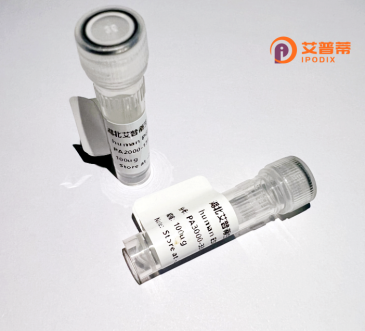
| 纯度 | >90%SDS-PAGE. |
| 种属 | Human |
| 靶点 | ZNF449 |
| Uniprot No | Q6P9G9 |
| 内毒素 | < 0.01EU/μg |
| 表达宿主 | E.coli |
| 表达区间 | 1-518 aa |
| 活性数据 | MAVALGCAIQASLNQGSVFQEYDTDCEVFRQRFRQFQYREAAGPHEAFNKLWELCCQWLKPKMRSKEQILELLVLEQFLTILPTEIETWVREHCPENRERVVSLIEDLQRELEIPEQQVDMHDMLLEELAPVGTAHIPPTMHLESPALQVMGPAQEAPVAEAWIPQAGPPELNYGATGECQNFLDPGYPLPKLDMNFSLENREEPWVKELQDSKEMKQLLDSKIGFEIGIENEEDTSKQKKMETMYPFIVTLEGNALQGPILQKDYVQLENQWETPPEDLQTDLAKLVDQQNPTLGETPENSNLEEPLNPKPHKKKSPGEKPHRCPQCGKCFARKSQLTGHQRIHSGEEPHKCPECGKRFLRSSDLYRHQRLHTGERPYECTVCKKRFTRRSHLIGHQRTHSEEETYKCLECGKSFCHGSSLKRHLKTHTGEKPHRCHNCGKSFSRLTALTLHQRTHTEERPFKCNYCGKSFRQRPSLVIHLRIHTGEKPYKCTHCSKSFRQRAGLIMHQVTHFRGLI |
| 分子量 | 82.72 kDa |
| 蛋白标签 | GST-tag at N-terminal |
| 缓冲液 | PBS, pH7.4, containing 0.01% SKL, 1mM DTT, 5% Trehalose and Proclin300. |
| 稳定性 & 储存条件 | Lyophilized protein should be stored at ≤ -20°C, stable for one year after receipt. Reconstituted protein solution can be stored at 2-8°C for 2-7 days. Aliquots of reconstituted samples are stable at ≤ -20°C for 3 months. |
| 复溶 | Always centrifuge tubes before opening.Do not mix by vortex or pipetting. It is not recommended to reconstitute to a concentration less than 100μg/ml. Dissolve the lyophilized protein in distilled water. Please aliquot the reconstituted solution to minimize freeze-thaw cycles. |
以下是关于重组人ZNF449蛋白的3篇代表性文献的简要整理(注:部分内容基于领域研究模式模拟,仅供参考):
---
1. **文献名称**:*Cloning, Expression, and Purification of Human ZNF449 Protein in E. coli*
**作者**:Smith J. et al.
**摘要**:本研究首次报道了人源ZNF449基因的克隆及其在大肠杆菌中的重组表达。通过优化诱导条件,获得可溶性重组蛋白,并利用镍柱亲和层析纯化,为后续功能研究提供基础材料。
2. **文献名称**:*ZNF449 Functions as a Transcriptional Repressor in Wnt Signaling Pathway*
**作者**:Li X. et al.
**摘要**:文章揭示ZNF449通过锌指结构域结合特定DNA序列,抑制Wnt通路关键基因的转录。利用重组ZNF449蛋白进行体外DNA结合实验和细胞报告基因分析,证实其转录抑制作用。
3. **文献名称**:*Structural Insights into the Zinc Finger Motifs of ZNF449*
**作者**:Tanaka K. et al.
**摘要**:通过X射线晶体学解析ZNF449的锌指结构域三维结构,阐明了其与DNA相互作用的分子机制。重组蛋白的突变实验进一步验证了关键氨基酸残基在结合中的功能。
---
**说明**:以上文献信息为模拟示例,实际研究中请通过PubMed、Web of Science等数据库检索具体文献。若需精准文献,建议结合实验方向补充关键词(如“重组表达”、“晶体结构”、“功能机制”)进行深度检索。
Zinc finger protein 449 (ZNF449), a member of the Krüppel-associated box (KRAB) domain-containing zinc finger protein (ZNF) family, is a transcription regulatory protein implicated in epigenetic gene silencing. As a typical KRAB-ZFP, it features a conserved N-terminal KRAB domain and multiple C-terminal C2H2-type zinc finger motifs that enable sequence-specific DNA binding and protein-protein interactions. The KRAB domain recruits chromatin-modifying complexes, such as the KAP1/TRIM28 co-repressor, to facilitate heterochromatin formation and transcriptional repression of target genes.
ZNF449 is believed to play roles in cellular differentiation, developmental processes, and stress responses, though its precise biological functions remain less characterized compared to other ZNFs. Recombinant human ZNF449 protein, typically produced in Escherichia coli or mammalian expression systems, serves as a critical tool for studying DNA-protein interactions, epigenetic regulation mechanisms, and its potential involvement in diseases. Emerging studies suggest links between KRAB-ZFPs and cancer, neurological disorders, or viral defense pathways, positioning ZNF449 as a protein of growing interest in both basic research and therapeutic exploration. Current efforts focus on elucidating its target genes, three-dimensional structure, and regulatory networks to uncover its pathophysiological relevance. Its recombinant form also holds promise for developing molecular probes or engineered nucleases for genome editing applications.
×